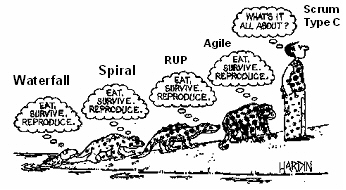
Love it or hate it, the Agile 2005 Conference reviewers thought the paper below was either a major innovation or a gross violation of the principles (dogma) of Scrum. It's motto is innovate or die and only the paranoid survive in the global economy. Does it show the future of Scrum? Well the paper was accepted for presentation at Agile 2005 and many people have asked for the real bits (all 27 pages) before I chop it down to the required 10 page IEEE paper. It could take you to CMM Level 4 or beyond. Decide for yourself whether this paper should be burned or nailed on a door somewhere!

Future of Scrum: Support for Parallel Pipelining of Sprints in Complex Projects
Jeff Sutherland, Ph.D.
ScrumMaster Training
Patientkeeper, Inc., Brighton, MA, US
Abstract
Scrum was invented to rapidly drive innovative new product to market. Six month releases used to be a reasonable time from for an enterprise system. Now it is three months for a major new release, one month for upgrades, and one week for maintenance releases. The initial version of the Agile Scrum development process was designed to enhance productivity and reduce time to market for new product. In this paper, one of the inventors of Scrum goes back to Scrum basics, throws out preconceived notions, and designs Advanced Scrum using multiple overlapping Sprints within the same Scrum teams. This methodology delivers increasing application functionality to market at a pace that overwhelms competitors. To capture dominant market share in 2005 requires a metaScrum for release planning, variable length Sprints, overlapping Sprints for a single team, pre-staging Product Backlog, daily Scrum of Scrums meetings, and automation and integration of Product Backlog and Sprint Backlog with real-time reporting. A practical example of Advanced Scrum describes how mobile/wireless product teams implemented Scrum process automation during 2000-2005. Administrative overhead for over 45 enterprise product releases a year was less than 60 seconds a day per developer and less than 10 minutes a day for a Project Manager. While Advanced Scrum is not for the uninitiated, the future of Scrum is still Scrum, just faster, better, and cooler.

